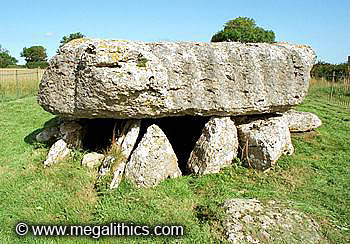
 |
|
Photo Gallery |
|
|
Panoramas |
|
|
|
Infrared |
|
| SH 50137 86043 (GPS 22min) | |
| Visited August 2001 |
The tomb at Lligwy is unusual, at 27 tons,
the capstone is massive, it is over 5m long and about 1m thick, yet the stones
supporting it are small, only raising the top of the capstone to 1.9m above the
ground. What makes Lligwy special is the way that the tomb has been built over a
pit, the supporting stones sit either on the rocky lip of the pit, or upon
drystone walling. Although the height under the capstone today is just over a
metre, the pit allowed an original clearance of 2m or more. The
use of a pit in this way has been interpreted as a means of creating a burial
space with the minimum of effort, and supposedly suggests a late date for the
tomb, perhaps in a time when only cursory attention was being given to old
traditions. Having seen the tomb "in the flesh", we thought that the
selection and manipulation of such a huge capstone was anything but an example
of economy of effort!
Excavated in 1909, two layers of burials were found separated by a layer of flat
stones, rather like the remains of a floor. The upper layer was covered with a
layer of limpet shells and contained human and animal bone, worked flints and
pottery sherds. The lower layer had a similar range of contents but rested upon
a bed of mussel shells. The bones were all unburnt and were from both sexes and
all ages, three fragments of bone were from unusually wide jawbones, suggesting
a familial trait. The pottery fragments all appear to be of late origin, and a
fragment with shell impressed decoration suggests a date of around 1800-2000BC
for the last burials in the tomb.
An opening to the east between two large supporting stones is thought to have
been the original entrance, which is not thought to have had a passageway.
Although no evidence of a covering cairn has been found, it is thought that one
existed originally and that its absence today is probably due to stone robbing
in antiquity.
Although Lligwy suffers from the dreaded "green railing" curse, at
least the enclosure here is reasonably large.